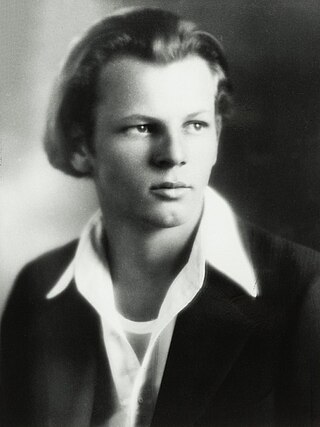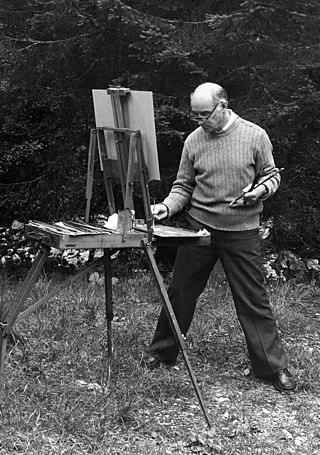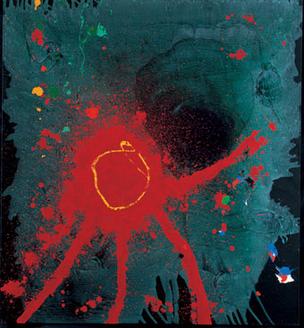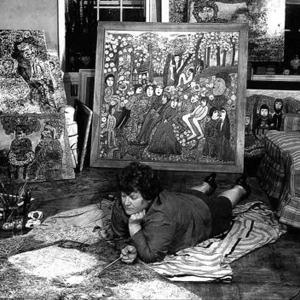Related Research Articles

Paul Jackson Pollock was an American painter. A major figure in the abstract expressionist movement, Pollock was widely noticed for his "drip technique" of pouring or splashing liquid household paint onto a horizontal surface, enabling him to view and paint his canvases from all angles. It was called all-over painting and action painting, since he covered the entire canvas and used the force of his whole body to paint, often in a frenetic dancing style. This extreme form of abstraction divided the critics: some praised the immediacy of the creation, while others derided the random effects. In 2016, Pollock's painting titled Number 17A was reported to have fetched US$200 million in a private purchase.

Paint is a liquid pigment that, after applied to a solid material and allowed to dry, adds a film-like layer, in most cases to create an image, known as a painting. Paint can be made in many colors and types. Most paints are either oil-based or water-based, and each has distinct characteristics.
Abstract expressionism in the United States emerged as a distinct art movement in the immediate aftermath of World War II and gained mainstream acceptance in the 1950s, a shift from the American social realism of the 1930s influenced by the Great Depression and Mexican muralists. The term was first applied to American art in 1946 by the art critic Robert Coates. Key figures in the New York School, which was the epicenter of this movement, included such artists as Jackson Pollock, Franz Kline, Mark Rothko, Norman Lewis, Willem de Kooning and Theodoros Stamos among others.

Abstract Impressionism is an art movement that originated in New York City, in the 1940s. It involves the painting of a subject such as real-life scenes, objects, or people (portraits) in an Impressionist-style, but with an emphasis on varying measures of abstraction. The paintings are often painted en plein air, an artistic style involving painting outside with the landscape directly in front of the artist. The movement works delicately between the lines of pure abstraction and the allowance of an impression of reality in the painting.

Clyfford Still was an American painter, and one of the leading figures in the first generation of Abstract Expressionists, who developed a new, powerful approach to painting in the years immediately following World War II. Still has been credited with laying the groundwork for the movement, as his shift from representational to abstract painting occurred between 1938 and 1942, earlier than his colleagues like Jackson Pollock and Mark Rothko, who continued to paint in figurative-surrealist styles well into the 1940s.

Op art, short for optical art, is a style of visual art that uses optical illusions.

Abstract art uses visual language of shape, form, color and line to create a composition which may exist with a degree of independence from visual references in the world.
Action painting, sometimes called "gestural abstraction", is a style of painting in which paint is spontaneously dribbled, splashed or smeared onto the canvas, rather than being carefully applied. The resulting work often emphasizes the physical act of painting itself as an essential aspect of the finished work or concern of its artist.

Monochromatic painting has played a significant role in modern and contemporary Western visual art, originating with the early 20th-century European avant-gardes. Artists have explored the non-representational potential of a single color, investigating shifts in value, diversity of texture, and formal nuances as a means of emotional expression, visual investigation into the inherent properties of painting, as well as a starting point for conceptual works. Ranging from geometric abstraction in a variety of mediums to non-representational gestural painting, monochromatic works continue to be an important influence in contemporary art.

Figurative art, sometimes written as figurativism, describes artwork that is clearly derived from real object sources and so is, by definition, representational. The term is often in contrast to abstract art:
Since the arrival of abstract art the term figurative has been used to refer to any form of modern art that retains strong references to the real world.

Joan Mitchell was an American artist who worked primarily in painting and printmaking, and also used pastel and made other works on paper. She was an active participant in the New York School of artists in the 1950s. A native of Chicago, she is associated with the American abstract expressionist movement, even though she lived in France for much of her career.

Hyperrealism is a genre of painting and sculpture resembling a high-resolution photograph. Hyperrealism is considered an advancement of photorealism by the methods used to create the resulting paintings or sculptures. The term is primarily applied to an independent art movement and art style in the United States and Europe that has developed since the early 1970s. Carole Feuerman is the forerunner in the hyperrealism movement along with Duane Hanson and John De Andrea.

Lyrical abstraction is either of two related but distinct trends in Post-war Modernist painting:

Painting is a visual art, which is characterized by the practice of applying paint, pigment, color or other medium to a solid surface. The medium is commonly applied to the base with a brush, but other implements, such as knives, sponges, and airbrushes, can be used.
Drip painting is a form of abstract art in which paint is dripped or poured on to the canvas. This style of action painting was experimented with in the first half of the twentieth century by such artists as Francis Picabia, André Masson and Max Ernst, who employed drip painting in his works The Bewildered Planet, and Young Man Intrigued by the Flight of a Non-Euclidean Fly (1942). Ernst used the novel means of painting Lissajous figures by swinging a punctured bucket of paint over a horizontal canvas.

Janet Sobel, born Jennie Olechovsky, was a Ukrainian-born American Abstract Expressionist painter whose career started mid-life, at age forty-five in 1938. Sobel pioneered the drip painting technique that directly influenced Jackson Pollock. She was credited as exhibiting the first instance of all-over painting seen by Clement Greenberg, a notable art critic.

The arts are a wide range of human practices of creative expression, storytelling, and cultural participation. They encompass multiple diverse and plural modes of thinking, doing, and being, in an extremely broad range of media. Both dynamic and a characteristically constant feature of human life, they have developed into innovative, stylized, and sometimes intricate forms. This is often achieved through sustained and deliberate study, training, and/or theorizing within a particular tradition, across generations, and even between civilizations. The arts are a vehicle through which human beings cultivate distinct social, cultural, and individual identities while transmitting values, impressions, judgements, ideas, visions, spiritual meanings, patterns of life, and experiences across time and space.

Informalism or Art Informel is a pictorial movement from the 1943–1950s, that includes all the abstract and gestural tendencies that developed in France and the rest of Europe during the World War II, similar to American abstract expressionism started 1946. Several distinguishing trends are identified within the movement such as lyrical abstraction, matter painting, New Paris School, tachisme and art brut. The French art critic Michel Tapié coined the term "art autre" in the homonymous book published in 1952 in relation to non-geometric abstract art. It was instrumental in improving the concept of abstract art in France during the Early 1950s. Its use in the expression of political ideologies in South America during the Early 1950s was quite common, as it was seen as the main way to show support for the changing political climate.

Gail Levin is an American art historian, biographer, artist, and a Distinguished Professor of Art History, American Studies, Women's Studies, and Liberal Studies at Baruch College and the Graduate Center of the City University of New York. She is a specialist in the work of Edward Hopper, feminist art, abstract expressionism, Eastern European Jewish influences on modernist art and American modernist art. Levin served as the first curator of the Hopper Collection at the Whitney Museum of American Art.
References
- ↑ "all-over painting Facts, information, pictures | Encyclopedia.com articles about all-over painting". Encyclopedia.com. Retrieved 2012-07-16.
- ↑ Archived October 7, 2009, at the Wayback Machine
- ↑ "All-over Painting". Artprofessor.com. Retrieved 2012-07-16.
- ↑ "ArtLex's Al-Am page". Artlex.com. 2007-02-16. Archived from the original on 2012-07-05. Retrieved 2012-07-16.
- ↑ "Directory of Art Services and Resources". artnet. Retrieved 2012-07-16.
- ↑ ROBERTA SMITHPublished: February 15, 2002 (2002-02-15). "ART IN REVIEW; Janet Sobel - New York Times". Nytimes.com. Retrieved 2012-07-16.
{{cite web}}: CS1 maint: numeric names: authors list (link)